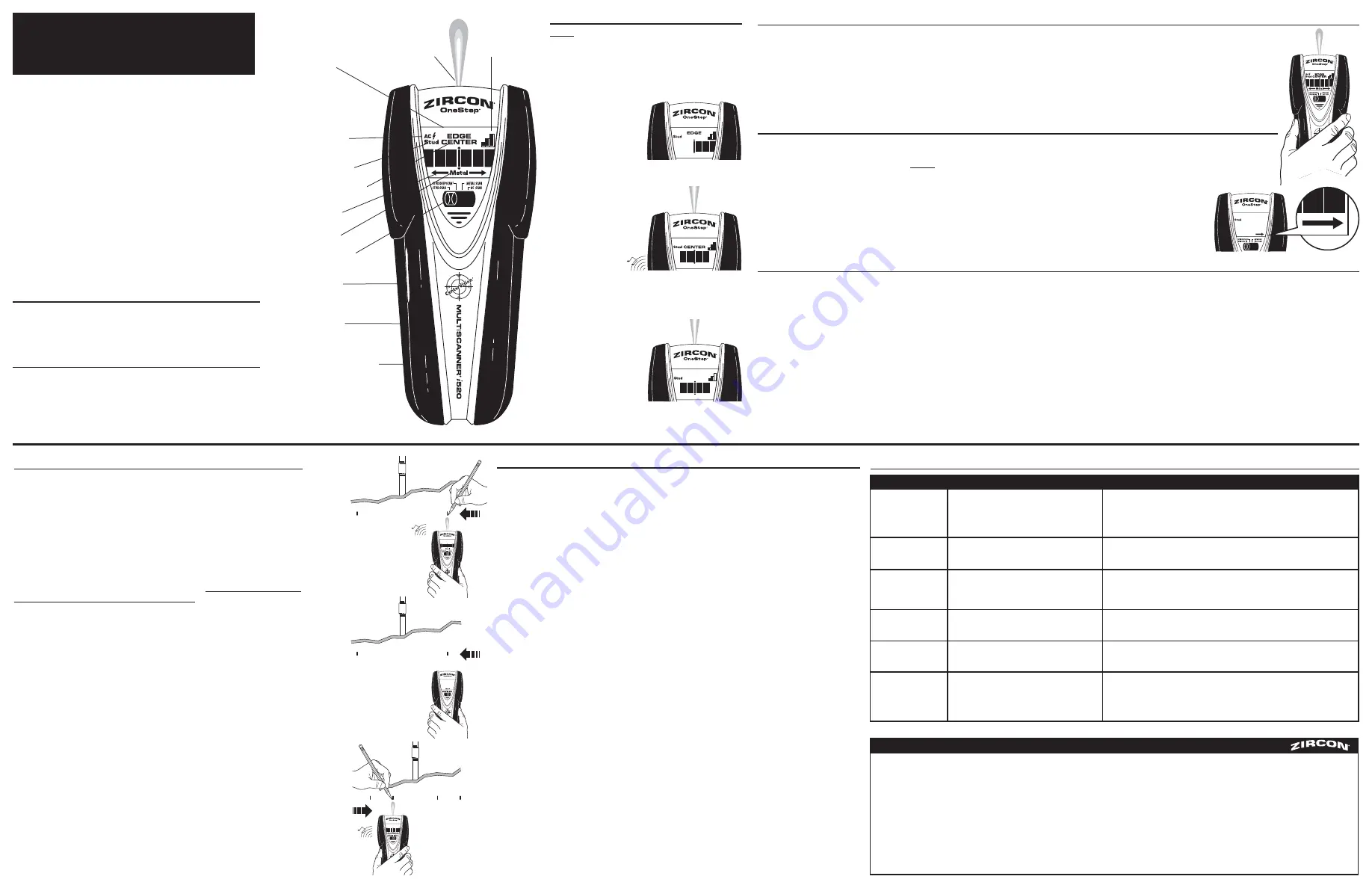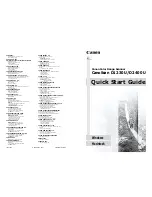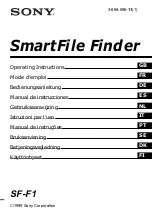
MultiScanner
®
i
520
OneStep
™
Multifunction Wall Scanner
1. INSTALLING THE BATTERY
Press battery door release in with your finger or a coin and lift up
to remove door. Connect 9-volt battery to cable. Place into the
compartment and press into place. Replace battery door and snap shut.
Battery will last approximately 2 years under normal conditions.
2. SELECTING THE MODE
Move selector switch to the desired mode: STUD SCAN for finding wood
or metal studs; DEEPSCAN
®
for scanning walls over 9 mm; METAL SCAN
for locating metal; or AC SCAN for locating live AC wiring.
Unit will remain off if POWER BUTTON is not depressed.
3. FINDING A STUD
Always scan for studs with the scanner placed
flat against the wall. Move the mode switch to
STUD SCAN, place the tool flat against the wall,
then press and hold the POWER BUTTON.
Wait for beep to confirm calibration has
completed before moving scanner.
Slowly slide tool across
surface. EDGE display
will illuminate, indicating
location of the stud edge.
Continue sliding tool.
When the center of a
stud is located with
three bars on the
Signal Strength
Indicator, the buzzer
will sound, and the
four middle bars,
CENTER display,
and SpotLite
®
Pointing System
will illuminate.
In cases of deeper studs
(or thicker walls) two bars
will show on the Signal
Strength Indicator and only
the SpotLite
®
Pointing
System and four middle
bars will illuminate. If you
still can’t locate a stud,
try STUD DEEPSCAN
®
Mode.
4. TIPS FOR PROPER OPERATION
For optimum scanning results, it is important to properly hold MultiScanner
®
i
520 and move slowly when scanning. The following tips will ensure
accurate scanning results:
• Grasp the handle with your thumb on one side and your fingers on the other side. Make sure your fingertips are resting on or above the running
board and not touching the surface being scanned or the scanning head of the tool.
• Hold the tool straight up and down, parallel to the studs, and do not rotate the tool.
• Keep tool flat against the wall and do not rock or tilt the tool when slowly sliding across the surface being scanned.
• Make sure your other hand or any other part of your body is not touching the surface being scanned. This could interfere with the tool’s performance.
5. CALIBRATING THE TOOL IN STUD SCAN/STUD DEEPSCAN
®
MultiScanner
®
i
520 can be calibrated anywhere on the wall. It constantly monitors the subsurface environment 10 times per second and automatically
recalibrates, when needed, to successfully find the center of studs in one step.
• Place MultiScanner
®
i
520 against the wall
before
pressing the POWER BUTTON in STUD SCAN or STUD DEEPSCAN
®
.
• Once powered on, tool will automatically perform all calibrations. The LCD will display all icons until calibration is complete.
Upon completion of calibration, the SpotLite
®
Pointing System and buzzer will momentarily activate and the tool will begin
continuous measurements. Continue to press the tool flat against the wall and begin scanning.
Note: It is important to wait for calibration to complete (1–2 seconds) before moving the scanner.
• ACT
™
(Auto Correcting Technology)—During scanning, the tool will automatically recalibrate itself when needed. This recalibration
is usually transparent and no indication is made. If the tool is initially calibrated near a stud and then moved away (it will detect
the density of the wall decreasing), an arrow icon will be illuminated, indicating the direction of the missed stud.
6. WORKING WITH DIFFERENT MATERIALS
Wallpaper:
The MultiScanner
®
i
520 functions normally on walls covered with wallpaper or fabric, unless the materials are metallic foil, contain metallic fibers, or are still wet
after application.*
*Wallpaper may need to dry for several weeks after application.
Lath & plaster:
Due to irregularities in plaster thickness, it is difficult for the MultiScanner
®
i
520 to locate studs in STUD SCAN Mode. Change to METAL SCAN Mode to
locate the nail heads holding wood lath to the studs. If the plaster has metal mesh reinforcement, MultiScanner
®
i
520 will be unable to detect through that material.
Textured walls or acoustic ceilings:
When scanning a ceiling or wall with an uneven surface, place thin cardboard on the surface to be scanned and scan over the
cardboard. Calibrate with cardboard in place.
Wood flooring, subflooring, or gypsum drywall over plywood sheathing:
Use DEEPSCAN
®
Mode and move the tool slowly. The signal strength indicator may only
display 1 or 2 bars when the tool locates a stud through thick surfaces.
MultiScanner
®
i
520 cannot scan for wood studs and joists through carpeting and pad. In problematic situations, try using METAL SCAN to locate nails or drywall screws that
line up vertically where a stud or joist is positioned.
Note: Sensing depth and accuracy can vary due to moisture content of materials, wall texture, and paint.
FCC Part 15 Class B Registration Warning
This equipment has been tested and found to comply with the limits for a Class B digital device, pursuant to Part 15 of FCC Rules.
7. SCANNING IN METAL MODE
Note: When scanning for metal studs, use STUD SCAN Mode (or STUD DEEPSCAN
®
on thicker walls) to quickly locate the center and edges of wood or metal studs.
Use METAL SCAN Mode only to determine if studs are wood or metal. In METAL
SCAN Mode, only metal drywall screws will be found in wood studs, while metal
will be indicated everywhere on a metal stud.
METAL SCAN Mode has interactive calibration to adjust to sensitivity, to metal, and
be used to find the precise location of metal objects in walls, floors, and ceilings.
Maximum sensitivity is ideal for quickly finding the approximate location of metal.
However, the user can reduce sensitivity by turning on the tool closer to metal.
The reason for reducing sensitivity is because with less sensitivity, the area where
metal is indicated will be smaller. But in both cases, the metal target is in the center
of the area where the tool indicates metal is present.
1. For maximum metal sensitivity, turn the tool on in the air by pressing and holding
the power button. This will ensure that it calibrates away from any metal objects.
(The tool can only be calibrated off the wall in METAL SCAN or AC SCAN Mode.)
2.
(Figure A)
While holding the power button, press the tool flat against the wall
and slowly slide the scanner across the surface. Mark the point where you get
the highest metal indication (the most bars on the screen). If it is a strong target,
the SpotLite
®
Pointing System will also shine a beam of light and a steady beep
will sound. Continue in same direction until display bars reduce. Reverse direction
and mark the spot where the display bars peak from the reversed direction.
The midpoint of the two marks is the location of the center of the metal object.
If the unit indicates metal over a large area, you can refine the scanning area
to more accurately locate the metal target.
3.
(Figure B)
To further pinpoint the location of the metal target, scan the area
again. Release the power button and then turn the unit back on, this time
starting on the wall over one of the previous marks. This will reset the tool to
a lower sensitivity and make the scan more precise.
4.
(Figure C)
Scan in both directions as in Step 1. The area indicated
should become smaller so you can more precisely identify the metal
location. This procedure can be repeated to narrow the field even further.
Note: Small targets or targets deep within the surface may only illuminate some of
the bars and not the center line or audio tone. In this case, use the highest indication
to determine the metal position.
8. SCANNING IN AC MODE
As with METAL SCAN Mode, AC SCAN Mode has interactive calibration and works in the same manner.
1. For maximum sensitivity to live AC wiring, turn the tool on in the air by pressing and holding the
power button. This will ensure that it calibrates away from any live electrical wire. (The tool can only
be calibrated off the wall in METAL SCAN or AC SCAN Mode.)
2.
(Figure A)
While holding the power button, press the tool flat against the wall and slowly slide the
scanner across the surface. Mark the point where you get the highest AC indication (the most bars
on the screen). If it is a strong target, the SpotLite
®
Pointing System will also shine a beam of light and
a steady beep will sound. Continue in same direction until display bars reduce. Reverse direction and
mark the spot where the display bars peak from the reversed direction. The midpoint of the two marks
is the location of the center of the live AC wiring. If the unit indicates live electricity over a large area,
you can refine the scanning area to more accurately locate the live AC wiring.
3.
(Figure B)
To further pinpoint the location of the live AC wiring, scan the area again. Release the
power button and then turn the unit back on, this time starting on the wall over one of the previous
marks. This will reset the tool to a lower sensitivity and make the scan more precise.
4.
(Figure C)
Scan in both directions as in Step 1. The area indicated should become smaller so you can
more precisely identify the location of live AC wires. This procedure can be repeated to narrow the field
even further.
Note: AC SCAN Mode will only detect live (energized) AC wiring.
WireWarning
®
Alert
Zircon’s WireWarning
®
Alert feature works continuously in all modes. When live AC voltage is
detected, the AC Alert warning icon will appear in the display. If scanning begins over a live
AC wire, the AC indicator will flash continuously.
CAUTION: Wires deeper than 51 mm from the surface, in plastic conduit, or behind
plywood shear wall may not be detected. Metal shielded wires or those in metal conduit
will not be detected. Use extreme caution under these circumstances or whenever live
AC wiring is present. Always turn off power when working near electrical wires
.
SpotLite
®
Pointing System
Ultra-bright
Display
Mode Selector Switch
Battery (back of unit)
Stud Scan Mode Indication
Stud Edge or Center Indication
AC Mode & WireWarning
®
Alert Indication
Metal Mode Indication
ACT
™
(Auto Correcting
Technology) Indication
Signal Strength
Indicator
Running Board
Power Button
Detects other objects
besides studs in STUD
SCAN Mode. Finds more
targets than there
should be.
Area of voltage appears
much larger than actual
wire (AC only).
Difficulty detecting metal.
Image of metal object
appears wider than
actual size.
Constant readings of
studs near windows
and doors.
You suspect electrical
wires, but do not
detect any.
• Electrical wiring and metal/plastic pipes may be
near or touching back surface of wall.
• Static charge may develop on drywall, spreading
voltage detection as much as 305 mm laterally
from each side of an actual electrical wire.
• Tool calibrated over metal object.
• Metal targets too deep or small.
• Metal has greater density than wood.
• Double and triple studs are usually found around
doors and windows. Solid headers are above them.
• Wires are shielded by metal conduit, a braided
wire layer, or metallic wall covering.
• Wires deeper than 51 mm from surface might
not be detected.
• Wires may not be live.
• Scan the area in METAL and AC SCAN modes to determine if metal or hot AC is present.
• Check for other studs equally spaced to either side 305, 406, or 610 mm apart or the
same stud at several places directly above or below the first.
Use CAUTION when nailing, sawing, or drilling in walls, floors, and ceilings
where these items may exist.
• To narrow detection, turn unit off and on again at the edge of where wire was first
detected and scan again.
• Place your free hand flat against wall near tool during the entire scan to drain static.
• The scanner may have been calibrated over a metal object, reducing sensitivity.
Try calibrating in another location.
• Scan in both horizontal and vertical directions. Metal sensitivity is increased when
metal object is parallel to sensor, located under Zircon logo.
• To reduce sensitivity, recalibrate MultiScanner
®
i
520 over either of first two marks.
(metal mode only)
• Detect outer edges so you know where to begin.
• Try METAL SCAN to see if you can find metal, wire, or metal conduit.
• Always turn off the power when working near electrical wires.
• Try turning on switches to outlet.
• Try plugging a lamp into outlet and turning on switch.
9. HELPFUL HINTS
(See also number 4, Tips for Proper Operation)
Situation
Probable Cause
Solution
LIMITED 2 YEAR WARRANTY
Zircon Corporation, (“Zircon”) warrants this product to be free from defects in materials and workmanship
for two years from the date of purchase. Any in-warranty defective product returned to Zircon*, freight
prepaid with proof of purchase date and $5.00 to cover postage and handling, will be repaired or replaced
at Zircon’s option. This warranty is limited to the electronic circuitry and original case of the product and
specifically excludes damage caused by abuse, unreasonable use or neglect. This warranty is in lieu of all
other warranties, express or implied, and no other representations or claims of any nature shall bind or
obligate Zircon. Any implied warranties applicable to this product are limited to the one year period
following its purchase. IN NO EVENT WILL ZIRCON BE LIABLE FOR ANY SPECIAL, INCIDENTAL OR
CONSEQUENTIAL DAMAGES RESULTING FROM POSSESSION, USE OR MALFUNCTION OF THIS PRODUCT.
In accordance with government regulations, you are advised that: (i) some states do not allow limitations
on how long an implied warranty lasts and/or the exclusion or limitation of incidental or consequential
damages, so the above limitations and/or exclusions may not apply to you, and further (ii) this warranty
gives you specific legal rights and you may also have other rights which vary from state to state.
Return product freight prepaid with proof of purchase date (dated sales receipt) and
$5.00 to cover postage and handling, to:
UPS SCS C/O ZIRCON RETURNS
Lohstrabe 30a
85445 Schwaig
Munich, Germany
Be sure to include your name and return address. Out of warranty service and repair,
where proof of purchase is not provided, shall be returned with repairs charged C.O.D.
Allow 4 to 6 weeks for delivery.
U.S. Patents 5917314, 6259241, 6989662, 7116091, and Patents Pending,
Canadian Patent 2341385, Japanese Patent 3581851, E.U. Patent Pending
©2008 Zircon Corporation • P/N 62297 • Rev B 06/08
The MultiScanner
®
i
520 OneStep
™
features four
scanning modes:
• Stud Scan Mode: Locates the center and edges of
wood and metal studs up to 19 mm deep
• Stud DeepScan
®
Mode: Locates the center of wood
and metal studs up to 38 mm deep
• Metal Scan Mode: Detects and locates ferrous
(magnetic) metal up to 76 mm deep and non-ferrous
(non-magnetic) metal up to 38 mm deep
• AC Scan Mode: Detects and locates live AC wires up
to 51 mm deep
• WireWarning
®
Alert automatically detects and alerts
the user to live AC wires in Stud Scan, Stud
DeepScan
®
, and Metal Scan modes
Visit www.zircon.com/support for the most current instructions.
ACT, CenterVision, DeepScan, MultiScanner, OneStep, SpotLite, WireWarning, and Zircon are registered trademarks or trademarks of Zircon Corporation.
Figure A
Figure B
Figure C





















